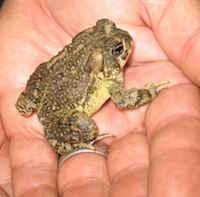 (1985, Australia) During my undergraduate years
at James Cook University, I read a short article in the local newspaper
regarding the peculiar antics of a pair of biology students required to
dissect a cane toad. (1985, Australia) During my undergraduate years
at James Cook University, I read a short article in the local newspaper
regarding the peculiar antics of a pair of biology students required to
dissect a cane toad.
The South American cane
toad, Bufo marinus, was introduced to Australia as a biological
control for the cane beetle, which destroys millions of dollars of sugar
cane each year. This was an environmental disaster! First, the toad never
developed a taste for cane beetles, but instead slaked its prodigious
appetite with all manner of endemic fauna. Second, its toxins are not
restricted solely to the two poison sacs behind its head, making it
poisonous fare for Australian wildlife during every stage of its lifecycle.
|
Toads of the genus Bufo
secrete a poisonous, mildly hallucinogenic alkaloid called Bufotenin,
C12H16N2O.
|
In short, this toad eats anything smaller than it is, and poisons anything
bigger.
Back in the laboratory, one student confidently bet his lab partner $20
that he would not swallow the ovaries of the cane toad they were
dissected. In need of money, and impressed with the magnanimous offer, the
lab partner ate the organs. He suffered FOUR cardiac arrests while in
transit to the hospital.
He is not eligible for a Darwin Award, since he did not die, but I suggest
that he deserves an At-Risk Survivor. I'd be interested to hear from
readers from Townsville who can wade through the back issues of the
Townsville Bulletin, and check the details.
The final sentence in the article suggested that we still do not know
enough about the cocktail of toxins possessed by the cane toad.
DarwinAwards.com © 1994 - 2020
Submitted by: Brett
Reference: Townsville Bulletin
Thanks to www.jcu.edu.au/school/tbiol/zoology/herp/tfrg/bufo.jpg
and www-astro.physics.ox.ac.uk/~erik/toad/images/bufo.marinus.hand.jpeg
for pictures!
|

